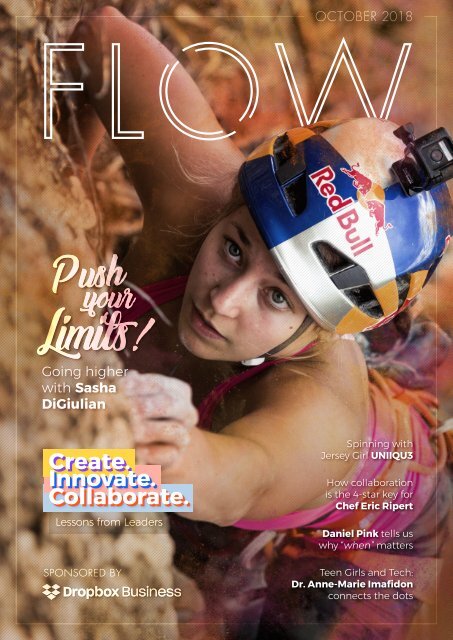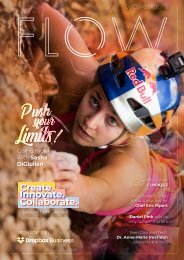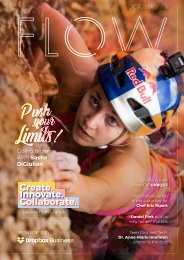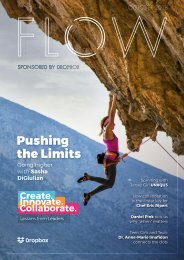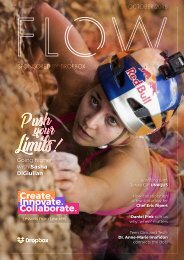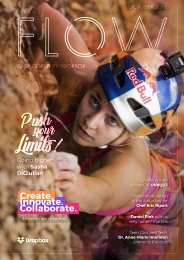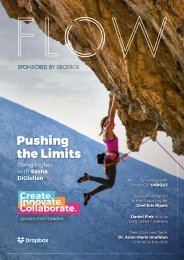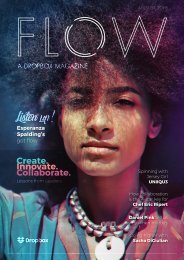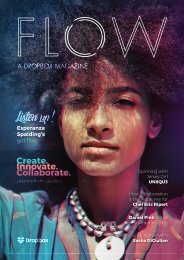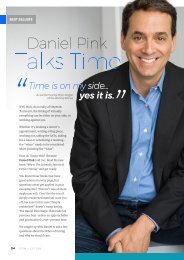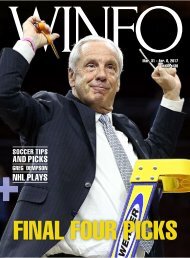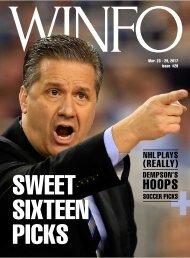WRC-DBB-OCT
You also want an ePaper? Increase the reach of your titles
YUMPU automatically turns print PDFs into web optimized ePapers that Google loves.
<strong>OCT</strong>OBER 2018<br />
Going higher<br />
with Sasha<br />
DiGiulian<br />
Create.<br />
Innovate.<br />
Collaborate.<br />
Lessons from Leaders<br />
SPONSORED BY<br />
Spinning with<br />
Jersey Girl UNIIQU3<br />
How collaboration<br />
is the 4-star key for<br />
Chef Eric Ripert<br />
Daniel Pink tells us<br />
why “when” matters<br />
Teen Girls and Tech:<br />
Dr. Anne-Marie Imafidon<br />
connects the dots
18TOXE<br />
CONTENTS<br />
What’s<br />
PLAYING CATCH-UP<br />
Declining meetings, talking hoops, taking it<br />
to the streets and Oscar on a budget. Did<br />
you miss anything?<br />
TICK TOCK<br />
Timing is everything in comedy...and Daniel<br />
Pink's latest best-seller<br />
AFTER THE YELLING<br />
Chef Eric Ripert stopped yelling - and that's<br />
when things got interesting<br />
THE GODFATHER<br />
When Michael Bierut talks... well you get<br />
the picture (he talked, we listened).<br />
BY WAY OF JERSEY<br />
Jersey girl UNIIQU3 takes her music and<br />
style around the world. And the world likes<br />
it<br />
BREAKING BIG<br />
An exciting new voice on the club scene,<br />
Swedish DJ/Producer TOXE is breaking out.<br />
CAN'T KEEP HER DOWN<br />
Sasha DiGiulian keeps going higher and<br />
higher, no matter what gets in her way.<br />
SHATTERING THE CEILING<br />
Dr Anne-Marie Imafidon’s is giving girls a big<br />
hammer and helping them swing away.<br />
02 FLOW <strong>OCT</strong>OBER 2018<br />
~
14<br />
MICHAEL<br />
BIERUT<br />
10<br />
GOING HIGHER<br />
WITH SASHA<br />
DIGIULIAN<br />
17<br />
UNIIQU3<br />
DAN PINK<br />
06<br />
DR.<br />
ANNE-MARIE<br />
IMAFIDEL<br />
12<br />
CHEF<br />
ERIC RIPERT<br />
08<br />
FLOW <strong>OCT</strong>OBER 2018<br />
~<br />
03
THE LEAD<br />
Lead<br />
The<br />
So you wanna make a ______.<br />
A hit song, a documentary movie, a new app, a goal line stand,<br />
life-changing medical discovery, a victory lap at Daytona, an<br />
updated logo, a dance routine... you go ahead and name it, and<br />
chances are whatever fills that blank for you, the role<br />
collaboration plays will be an essential one.<br />
Collaboration is the fuel for creativity and innovation. It's about<br />
creating something...whether substantive and lasting or<br />
ephemeral and fleeting. Collaborating, creating, innovating is an<br />
ever-present thread in all of our lives.<br />
With that, in this issue we're delighted to present innovators<br />
from a broad range of sectors, with a focus on the intersection<br />
between collaboration, creativity and personal expression.<br />
"Entrepreneurship is about creating new things and making them<br />
happen", said one of our leaders, Dr. Anne-Marie Imafidon, and<br />
making things happen is what she's doing.<br />
As are Sasha Digiulian (innovation thousands of feet up a rock<br />
wall), Michael Beirut (the design master), UNIIQU3 (powering<br />
parties around the world), Chef Eric Ripert (perfecting flow in the<br />
culinary world), Toxe (creating edgy beats) and Daniel Pink<br />
(corralling the relentless flow of time).<br />
The way we collaborate is constantly evolving, racing forward,<br />
eliminating the need for physical presence, but connectivity<br />
remains as important as ever to the flow of the creative process.<br />
Whatever your passion, this group will inspire you to connect,<br />
create, innovate and produce.<br />
A victory-lap at Daytona?<br />
Collaboration is the fuel.<br />
Credit: Getty Images<br />
04 FLOW <strong>OCT</strong>OBER 2018<br />
~
in case you<br />
missed it ...<br />
WALKING THE TIGHTROPE<br />
FIVE ON FIVE<br />
There’s a steady stream of engaging<br />
content flowing on the Dropbox Blog,<br />
from compelling interviews to daily<br />
optimization tips, to thought provoking<br />
pieces on globally relevant topics.<br />
In case you missed it, here are five<br />
blog posts we particularly enjoyed.<br />
“I think I can be a great mom and a great CEO, just not at the<br />
same time…That’s just the superwoman myth… if we try to<br />
follow (that), we’re going to burn ourselves out.”<br />
Moms and daughters come together in a super-cool event,<br />
Daughters of the Evolution, to share stories and discuss<br />
how they approach the challenge of "work-life" balance.<br />
Read more: Top tech women and their daughters discuss<br />
balancing family and success »<br />
“Something I think creatives do best is how we tackle<br />
problems.”<br />
Combine innovative artists, activism, a space, the tools and<br />
nine-hours...what do you get. Jessica English takes us from<br />
start to finish.<br />
Read more: Going behind the collaborative process: 3 murals<br />
come to life at SXSW in Austin, Texas »<br />
“We went through this together, and now, I can trust you with<br />
anything because we journeyed and grew together as partners.”<br />
LESS IS MORE?<br />
James Laxton, the cinematographer from Moonlight, last<br />
year’s Best Picture winner talks to Alice Tynan about<br />
winning, creativity and the benefit of low-budgets.<br />
“If you had to identify, in one word, the reason why the human<br />
race has not achieved, and never will achieve, its full potential,<br />
that word would be meetings.” - Dave Barry<br />
Picking up on a Salon.com study in which 47% of<br />
respondents highlighted too many meetings as their<br />
biggest time suck at work, Sage Cohen went about testing<br />
the theory - by declining every meeting request for an<br />
entire week. How did it turn out?<br />
Read more: Think More and Embrace Mistakes »<br />
Read more: 8 gains from a week without meetings »<br />
“One of my favorite things about my job is I have new things to<br />
work on every day.”<br />
A few weeks before the Golden State Warriors and their fans<br />
celebrated their third NBA Championship in four years, Ben<br />
Taylor caught up with Warriors' assistant general manager<br />
Kirk Lacob for a look behind the scenes of one of sport's<br />
most successful organizations.<br />
Read more: The Team Behind the Team »<br />
FLOW <strong>OCT</strong>OBER 2018<br />
~<br />
05
BEST SELLERS<br />
Daniel Pink<br />
Time is on my side...<br />
As performed by Mick Jagger<br />
of the Rolling Stones yes it is.<br />
Well Mick, that really all depends.<br />
Turns out, the timing of virtually<br />
everything can be either on your side, or<br />
working against you.<br />
Whether it’s booking a doctor’s<br />
appointment, writing a blog piece,<br />
working out, taking the SATs, asking<br />
for a raise or scheduling a meeting -<br />
the “when” needs to be considered<br />
when planning the “what”.<br />
How do I know this? Because<br />
Daniel Pink told me. Read his new book<br />
“When: The Scientific Secrets of Perfect<br />
Timing” and get ready.<br />
You know those books that have<br />
great advice on every page, but<br />
somehow never get applied in your<br />
everyday life? This isn’t one of them.<br />
Apply you will. Don’t let the ton of<br />
deeply researched material scare you<br />
off, because in this case “deeply<br />
researched” doesn’t mean boring.<br />
The Daniel Pink magic that made his<br />
previous best-sellers so approachable<br />
and provocative is ever-present here.<br />
We caught up with Daniel to ask a few<br />
questions about the When of timing<br />
and why we should care.<br />
06 FLOW <strong>OCT</strong>OBER 2018<br />
~
DAY-TO-DAY WHEN<br />
Q: About 30 pages into When, a mounting sense<br />
of lost opportunity waved over me as I realized<br />
I've been doing it wrong all these years (damn<br />
you, late afternoon meetings with Finance!).<br />
This may well be one of the best books on<br />
optimization I've read in years (and I've read a<br />
lot of them). There are practical, executable<br />
tips throughout.<br />
With that in mind, how has your work routine<br />
changed post-research compared to<br />
pre-research for the book, if at all?<br />
Daniel: It’s changed may own routines in several<br />
ways. Let me offer two.<br />
First, once I began understanding the research<br />
on peaks, troughs, and recoveries, I reorganized<br />
my day. Since I’m a more of a lark than an owl,<br />
my peak is the morning. That’s when I’m best<br />
doing analytic work - like conjuring words and<br />
trying to make them march in formation. So<br />
early in the writing of the book, I took a new<br />
approach. Every morning, I came into my office<br />
- the garage behind my house - around 830. I<br />
gave myself a word count - usually around 700<br />
or 800 words. And I didn't do anything else until<br />
I wrote the required number of words. No<br />
checking email. No watching sports highlights.<br />
Nothing. I didn’t even bring my phone into the<br />
office. By doing that every day - 700 words<br />
today, 800 words the next<br />
day, another 800 the day after<br />
that - the pages begin piling<br />
up. And, believe it or not, this<br />
book on timing was the first<br />
book I ever delivered on time!<br />
Second, I’ve become more<br />
systematic about taking<br />
breaks. Each day, on my list of<br />
ngs to do, I try to schedule at<br />
least one afternoon break. And<br />
those breaks almost always<br />
abide by the design principles<br />
that science tells us make<br />
breaks most effective -<br />
moving, outside, social, and<br />
fully detached. So in the<br />
afternoon, you might see me<br />
walking around my neighborhood - often with<br />
my wife, but never with my phone. I used to<br />
think that amateurs take breaks and<br />
professionals don’t. Now I understand that the<br />
truth is the opposite: Professionals take breaks.<br />
It’s the amateurs who ignore breaks.<br />
COLLABORATION WHEN<br />
Q: Daniel, as I mentioned, this book has<br />
optimization tips throughout. If you and I had<br />
the opportunity to walk the National Mall for<br />
30 minutes chatting about When and its<br />
relationship to the collaborative process,<br />
what's one actionable tip I would take away?<br />
Daniel: I’d ask us to spend 15 of those minutes<br />
talking not about how to collaborate more<br />
effectively and instead talking about why we’re<br />
collaborating in the first place. What are we<br />
trying to accomplish? Why are we doing this in<br />
the first place? What’s the point of the exercise?<br />
Then I’d schedule a separate time for a<br />
pre-mortem. In this technique, created by<br />
psychologist Gary Klein, we look out, say, one<br />
year from now and imagine that our shared<br />
project is a bust. Then we try to figure out what<br />
went wrong. And then, returning to the present<br />
day, we set up ways to avoid those pitfalls. I’d<br />
much rather make mistakes in my head in<br />
advance than in real time on a real project.<br />
SINGING WHEN<br />
Q: When has received a lot of press and reviews<br />
since it came out and landed on the best-seller<br />
list. Is there anything in the book that you<br />
thought would receive more attention, but<br />
hasn’t?<br />
Daniel: I thought the material on choral singing<br />
- the fact that it’s basically as good for us as<br />
physical exercise - would have gotten more<br />
attention. That said, there’s still, er, time!<br />
Looking for more from Daniel? Check out his<br />
fantastic Ted Talk on motivation below or visit<br />
DanPink.com to connect with him on social media<br />
and read more about When and his five other books,<br />
including other New York Times bestsellers A Whole<br />
New Mind, Drive and To Sell is Human.<br />
The Puzzle<br />
of Motivation<br />
Dan Pink<br />
FLOW <strong>OCT</strong>OBER 2018<br />
~<br />
07
COLLABORATE<br />
in the kitchen<br />
Collaboration<br />
&<br />
Q A<br />
with Chef Eric Ripert<br />
My Dad held up his glass to mine and proclaimed<br />
“to easily one of the best meals I’ve ever had”.<br />
~~~~~~~~~<br />
Perhaps predictable when dining at Le Bernardin, the revered<br />
Michelin three-star restaurant in New York, but to this day that<br />
experience (a treat from my Dad on our first trip to New York back<br />
in 2014) stands out as a truly memorable culinary event for both<br />
of us.<br />
The evening was a study in collaboration and creativity.<br />
From the first step in the door the team produced a<br />
seamless flow of exceptional hospitality, ambience,<br />
service and food.<br />
As the chef and co-owner of Le Bernardin, Eric Ripert’s<br />
part in this orchestra of teamwork is not insignificant.<br />
We caught up with Chef Ripert to talk creativity,<br />
collaboration and a surprising new option that<br />
needed both to make the menu.<br />
Q: Chef Ripert, can you talk the collaborative<br />
process at Le Bernardin? And the evolution, if<br />
any, in how you approach collaborating today<br />
vs. when you first began your career?<br />
Chef: Teamwork at Le Bernardin is everything.<br />
Whether creatively collaborating on a new<br />
dish or ensuring an evening in the dining<br />
room runs smoothly, our employees are our<br />
family and must all work together with<br />
respect and harmony. We have an<br />
unbelievably loyal team - many of the<br />
members have been with us for more than<br />
20 years! We have a warm relationship and<br />
overwhelming dedication that makes it<br />
easy for them to understand and share our<br />
vision with every guest who joins us at Le<br />
Bernardin.<br />
08 FLOW <strong>OCT</strong>OBER 2018<br />
~
Previously, I used to be a very authoritative<br />
chef. I would yell at my cooks and had very<br />
little tolerance and patience. It was the style<br />
of management that I learned from other<br />
chefs during my early years of training.<br />
Around 2000, I started to contemplate the<br />
kitchen’s atmosphere; we were losing a lot<br />
of employees and I was confused. I decide to<br />
re-evaluate the way I manage people<br />
and I realized something in<br />
myself - I couldn’t be<br />
happy if I was<br />
angry; those emotions<br />
can’t coexist. Now, we<br />
don’t yell at Le Bernardin,<br />
there is no drama. Today<br />
we have arrived at a certain<br />
level of management where<br />
the team is happy to work<br />
together, and even during<br />
our busiest times, we have<br />
a peaceful environment.<br />
Q: Le Bernardin recently<br />
introduced a vegetarian<br />
tasting menu option. Can<br />
you take us through the<br />
creative process you and your team went through as<br />
you designed this new option.<br />
Chef: In January of 2018, for the first time ever, Le<br />
Bernardin created a Vegetarian Tasting Menu. The goal<br />
of this menu is to highlight vegetables in the same<br />
focused and dedica ted way that we’ve always treated<br />
fish – to simply elevate the quality and freshness of<br />
each ingredient. The creative process is not something<br />
you can control and you never know when inspiration<br />
will hit.<br />
To develop this menu, as with any of our other dishes,<br />
we rely on teamwork and collaboration. What I ask my<br />
sous chefs, and also impose on myself, is to take notes<br />
whenever they have an idea. I write it down on<br />
whatever piece of paper I have nearby. Eventually, I<br />
bring all of the papers together; I carve out a spot<br />
conducive to creativity – calm, quiet, clutter-free.<br />
Sometimes, an idea sounds really good and we’re<br />
excited to pursue it, but when we try it, we realize it’s<br />
not at all what we expected. We don’t rush ourselves.<br />
We work on new dishes and sometimes we get lucky<br />
and it only takes us a few days to master them, and<br />
other times it takes months.<br />
A best-selling author, TV host and regular guest on a variety<br />
of food-focused programs, Eric Ripert has built a reputation<br />
as one of the world’s preeminent chefs. His flagship<br />
restaurant, Le Bernardin is consistently ranked amongst the<br />
best dining establishments in the world.<br />
Keep up with Eric on Twitter (Eric Ripert) and Le Bernardin<br />
FLOW <strong>OCT</strong>OBER 2018<br />
~<br />
09
CREATE<br />
Sasha DiGiulian talks<br />
in climbing<br />
As she summits a towering 2,300-foot granite dome<br />
in Madagascar, Sasha DiGiulian books another in a<br />
list of impressive “firsts”, this one the first<br />
female ascent of Mora Mora, ranked as one of<br />
the most difficult climbing routes in the world.<br />
I knew who Sarah was before Mora Mora, but<br />
reading about that climb dialed me in. I had<br />
a chance to connect with this top<br />
American climber to talk collaboration,<br />
creativity and inspiration.<br />
10 FLOW <strong>OCT</strong>OBER 2018<br />
~
Q: Sasha, what does collaboration look like when<br />
prepping for a climb? And what does it look like when<br />
you're on the climb?<br />
Sasha: While climbing is an intrinsically individual<br />
sport, more often than not it is not possible without<br />
a climbing partner. I have a really special<br />
relationship with each climbing partner that I<br />
have because there is a lot of trust built into<br />
this dynamic.<br />
Currently, my climbing partner (Edu<br />
Marin) and I are prepping for a<br />
two-month long trip in the Canadian<br />
Rockies around the Banff region. We<br />
have three big walls of the most<br />
challenging technical faces that we<br />
want to complete, each in one day. In<br />
order to prepare for this project we have<br />
been mapping out the gear that we<br />
need; from ropes, to trad and sport<br />
gear, to the on-the-wall sleeping<br />
gear, etc.<br />
Q: What role does creativity play<br />
when you're on a climb?<br />
Watch Sasha completing the first female ascent of<br />
American Hustle in Oliana, Spain<br />
A Columbia University grad, when Sasha’s not ascending a<br />
grade 9a, 5.14d (as the first North American woman to climb<br />
what is recognized as one of the hardest sport climbs<br />
achieved by a female), she gives her time to organizations<br />
that inspire the pursuit and access to sports, and female<br />
empowerment. She is on the Board of the Women's Sports<br />
Foundation and serves as a Global Athlete Ambassador for<br />
Right to Play, Up2Us Sports, and the American Alpine Club.<br />
Check out what’s she up to today - Sasha DiGiulian<br />
Sasha: Climbing is all about solving a<br />
gigantic jigsaw puzzle; putting<br />
individual pieces of the puzzle together<br />
in order to “send” or “summit” the<br />
climb. The creative process mainly<br />
happens during the climb - there is an<br />
element of visualization and<br />
thoughtfulness that happens beforehand<br />
but a lot of the creativity is packaged<br />
within the flow experience of climbing.<br />
Q: What inspired you to start climbing and<br />
what's inspired you to keep climbing?<br />
Sasha: I started climbing when I saw six; I<br />
loved the fact that I was in control of how I<br />
moved up the wall.<br />
Climbing is this input-output formula; what you<br />
put into it is what you get out of it. This varies at<br />
times - the effort that I put towards training,<br />
exploration, and big projects, but what has<br />
remained constant is my passion for it. I love how<br />
climbing has taken me around the world, given me a<br />
lens to experience remote corners and interact with<br />
different cultures.<br />
I love the process of not knowing I am capable of doing<br />
something, physically, then revealing to myself what I<br />
am capable of when I figure out the mental side. There<br />
are many aspects of climbing that I love; the sheer<br />
physical experience, the mental puzzle-solving, and<br />
the community.<br />
FLOW <strong>OCT</strong>OBER 2018<br />
~<br />
11
INNOVATE<br />
in social enterprise<br />
Three numbers that help paint the picture of Dr Anne-Marie<br />
Imafidon’s journey thus far. You don’t have to talk very long with<br />
anyone who knows Anne-Marie before you’re very likely to hear the<br />
terms inspirational, tireless, ambitious and prodigy.<br />
3 of 70. The number of girls in Anne-Marie’s class at university.<br />
20. Anne-Marie’s age when she graduated from Oxford University<br />
with a Master’s in Computer Science.<br />
38,500. The number of young women who have been<br />
inspired into Science, Technology, Engineering and Math<br />
careers through the STEMettes program co-founded by<br />
Anne-Marie.<br />
Anne-Marie envisions a science and tech<br />
community where women are equal<br />
contributors at every level, from the<br />
engineering department to being<br />
founders and funders...and every day<br />
she focuses on making this a reality.<br />
We caught up with her to talk<br />
STEMettes, soft skills and 2028<br />
~~~~~~<br />
Q: Anne-Marie, when working<br />
with young women interested in<br />
STEM and entrepreneurship, obviously<br />
there's a healthy focus on core skills, but<br />
can you talk a bit about the conversations<br />
you're having around creativity and STEM?<br />
Anne-Marie: The conversations are intertwined. To be great in<br />
STEM you need to be in tune with the arts. We talk about the fact<br />
that you are more likely to win a Nobel Prize in Science if you’ve<br />
engaged with the creative arts as part of your upbringing. If you are<br />
able to explore that creative side it makes you a better scientist and<br />
a better technologist.<br />
STEM is creative. It is about problem-solving. Entrepreneurship is<br />
about creating new things and making them happen, so there is a lot<br />
of talk about that and how you use creative skills to then make that a<br />
12 FLOW <strong>OCT</strong>OBER 2018<br />
~
a reality if you had the idea.<br />
For us, we find it liberating to allow the girls to explore<br />
when we give them tasks, it’s always done to a theme,<br />
so that is how we explore with young women, even if<br />
they are not interested in STEM.<br />
Q: We're currently seeing an explosion in the ability<br />
for people to collaborate. This is due to many factors,<br />
but amongst them is a new generation mobile<br />
devices, apps, cloud-based applications, and the<br />
increasing availability of inexpensive internet access.<br />
As someone who is focused on ensuring females will<br />
be at the forefront of tech's evolution, how do you see<br />
this trend impacting the young women you work with?<br />
Anne-Marie: In terms of the increase in being able to<br />
collaborate across different places, what we are seeing<br />
is that it is allowing people from different places to<br />
work together.<br />
But also for the young women, it’s<br />
meaning that when they start<br />
working there is going to be a<br />
better environment, an<br />
environment that’s more likely<br />
to be empowering for them<br />
and allow them to flourish.<br />
Because it’s using more of<br />
an altruistic, more<br />
collaborative side to get<br />
things done in a way that<br />
allows them to be more<br />
successful than people that<br />
do not take advantage of that<br />
collaboration - of that<br />
teamwork - and of using those<br />
devices and of that community<br />
building effectively to make<br />
things happen, to make change<br />
and to grow whatever it is that<br />
they are doing or building.<br />
You are seeing this a lot with this generation. Young<br />
women are doing very well in a space that is<br />
completely new where you are seeing that less from the<br />
kind of traditional groups who are used to hierarchies<br />
and closed types of working.<br />
Q: Anne-Marie, for 14 and 15-year old STEMettes,<br />
what does the tech sector look like for them in 2028?<br />
Anne-Marie: My hope is that by 2028 those 14 and<br />
15-year-olds will have more routes than ever, not only<br />
to access tech, but to be drivers and creators in tech.<br />
Also, there will have been a whole generation of digital<br />
natives and they will be able to think through and even<br />
anticipate more of the unintended consequences of our<br />
relationships with tech than the current generations<br />
have been able to.<br />
There is a lot of chat about ethics, there is a lot of chat<br />
about how the workplace is changing and I think by<br />
then we are looking at more home and life and how we<br />
interact with each other.<br />
So thinking about 14 and 15-year-olds it won’t be<br />
purely about profit.<br />
It’s not that money will ever stop talking, but there will<br />
be other facets alongside money that talk, which<br />
means if we’re discussing privacy, security and<br />
well-being, all of that will be baked into either<br />
technologies that are taking off, or companies that are<br />
doing well.<br />
As referenced above, Anne-Marie is one Oxford University’s<br />
youngest graduates. After a career in finance she turned her<br />
attention full-time to the STEMettes, a lauded and<br />
award-winning social enterprise. You can keep up with<br />
Anne-Marie on Twitter and the STEMettes website.<br />
Anne-Marie Imafidon,<br />
founder and CEO of<br />
STEMettes.org, speaking at<br />
the CYBERUK 2018 security<br />
conference in Manchester,<br />
England.<br />
FLOW <strong>OCT</strong>OBER 2018<br />
~<br />
13
CREATE<br />
Creativity<br />
with<br />
Michael Bierut<br />
I’m sitting on a park bench on an<br />
unseasonably warm fall afternoon,<br />
with a book and an iced coffee.<br />
The park? Central, around 68th on<br />
the upper west side. The book? How<br />
to use graphic design to sell things,<br />
explain things, make things look better,<br />
make people laugh, make people cry<br />
and (every one in a while) change the<br />
world... by Michael Bierut. The<br />
coffee? Hazelnut, from Sensuous<br />
Bean on 70th.<br />
~~~~~~<br />
in design<br />
The symmetry of reading a Michael<br />
Bierut book in New York City was not<br />
lost on me. Well beyond their<br />
physical address, Michael, and<br />
Pentagram, the design studio he’s<br />
called home for close to 30 years, are<br />
part of the city’s esthetic, flow and<br />
story.<br />
From guiding pedestrians via the<br />
expansive wayfinding system,<br />
signage and graphics for the New<br />
York Times headquarters, Saks Fifth<br />
Avenue bags, the Penn Station<br />
Concourse graphics, the New York<br />
Botanical Gardens logo, working with<br />
the New York Jets and more – a walk<br />
in the city is, in many ways, a walk<br />
with an iconic studio and a graphic<br />
design legend.<br />
We didn’t have a chance to go for a<br />
walk, but we did connect with<br />
Michael to talk design.<br />
14 FLOW <strong>OCT</strong>OBER 2018<br />
~
Q: Michael, what's the collaborative process for you and<br />
your team when you start working on a new project?<br />
Michael: Every partner at Pentagram manages their own<br />
small team, and I’ve noticed that every team approaches<br />
collaboration a little differently. When I get a new<br />
assignment, I usually bring in one of my designers to work<br />
with me on it. That designer will take the lead on the<br />
project management and ultimately has the responsibility<br />
to see that it’s going to be done right.<br />
Sometimes a project is complex and will require a bigger<br />
team. For instance, if a project combines identity and<br />
environmental graphics, I might bring in two designers,<br />
one for each area. Other times one designer takes a lead<br />
and others are pulled in, often to provide specialized<br />
assistance for a specific part of the job. Because we all work<br />
together in a big open plan office, people are making<br />
connections informally on a continuous basis.<br />
Q: To follow up on that, can you provide an example of an<br />
ideal collaborative experience with a client?<br />
Michael: Having a client participate in the creative process<br />
is a way to increase the chances that they’ll understand,<br />
and fully commit to, the final recommendation. Because so<br />
much work depends on the quality of its ongoing<br />
implementation - work that is often done in house, or by<br />
other agencies - we invest a lot of time in making sure the<br />
client sees the solution as something they can take full<br />
possession of. That said, our clients seldom expect to be<br />
“co-designing” with us: they come to Pentagram because<br />
they respect our expertise and look to us for leadership.<br />
In my experience the key is to avoid “presentation mode”<br />
- those sessions when salesmanship overtakes empathy -<br />
and keep actively listening through the whole process.<br />
Q: How has your creative process evolved over the years<br />
when working on identity design projects?<br />
Michael: Although the technological context of brand<br />
identity has changed radically in every possible way since I<br />
began in 1980, I honestly can’t say my creative process has<br />
changed that much. I think as I’ve gotten more mature,<br />
I’ve come to realize that clever solutions sometimes work<br />
beautifully at the moment of launch but don't stand up to<br />
the test of time. Simple ideas tend to endure, and it takes<br />
restraint and even humility to stay simple.<br />
Q: From what I can remember, 20 years ago, when an<br />
established company changed their logo, it barely<br />
registered outside the design community. Not so today.<br />
What's changed? Is it a function of social media?<br />
Michael: It may not be only social media, but it is<br />
technology. Logos are no longer just things that people<br />
encounter (and usually pay no attention to) on the sides of<br />
trucks or the ends of commercials. Instead, they’re icons<br />
FLOW <strong>OCT</strong>OBER 2018<br />
~<br />
15
Watch as Michael Bierut and Joe Poesner explain how a simple mark ends up<br />
meaning something big as a great logo.<br />
that they press their fingers on dozens a time a day<br />
(or an hour).<br />
After decades of brands hoping that consumers will<br />
adopt them as badges of personal identification, that<br />
dream is coming true to a somewhat scary degree. So<br />
people increasingly feel that they own the brands as<br />
much as the entities that the brand identities purport<br />
to represent.<br />
And thanks to social media, they’ve been invited to<br />
talk directly to those brands, most of whom<br />
desperately wanted this degree of intimacy, and<br />
many of whom got more than they bargained for.<br />
Michael Bierut, a partner at Pentagram since 1990, is<br />
a senior critic in graphic design at the Yale School of<br />
Art and a lecturer in the practice of design and<br />
management at the Yale School of Management.<br />
He is a co-founder of the popular and informative<br />
website Design Observer and the author of several<br />
books, including his newest, Now You See It, his<br />
collection of essays, published in fall 2017.<br />
16 FLOW <strong>OCT</strong>OBER 2018<br />
~
CREATE<br />
Creativity<br />
with UNIIQU3<br />
in the club<br />
Electrifying producer, DJ, rapper and<br />
musician. The rising star that is UNIIQU3<br />
talks collaboration, influences and<br />
trusting herself.<br />
~~~~~~<br />
Q: What do you look for in a possible<br />
collaboration?<br />
UNIIQU3: What I look for when I’m trying to<br />
collaborate is swag. Every rapper, singer and<br />
producer has a different swag. I make music that’s<br />
so different and I always like to challenge myself<br />
to try stuff that’s foreign to me. That’s the only<br />
way I’m gunna grow as a musician.<br />
different about me. It continuously brings me<br />
success. I also learned to be a BOSS and give<br />
people what I expect to receive. I got high ass<br />
standards too. Those are life lessons.<br />
Hailing from Newark, New Jersey, UNIIQU3 has broken out<br />
big, universally regarded as one of the top young producers<br />
in the EDM space. Take a few minutes to listen to her latest<br />
(and not so latest) tracks on the UNIIQU3 Soundcloud, and<br />
keep up with her on the UNIIQU3 Instagram.<br />
Q: You're taking your version of the Jersey Club<br />
sound all over the globe, bringing your unique<br />
(no pun intended) perspective and influencing<br />
those music scenes. Have those international<br />
shows influenced your creativity?<br />
UNIIQU3: The pun could be intended HAHA!! I’ve<br />
been so many places! London, South Korea,<br />
Australia, Mexico so YES traveling and performing<br />
internationally has influenced me creatively. I like<br />
linking up with other producers and DJs<br />
everywhere I go. I also go to local shows, be a<br />
tourist and listen to the radio stations to get<br />
inspiration. I’m one of those musicians that likes<br />
to cater to the audience they’re performing for.<br />
Depending on the city or country I’m in, I like to<br />
pay homage to the sounds that those places<br />
birthed and play my take on their sound, which<br />
would be a Remix I produced or rapped on.<br />
Q: What have you learned in your career so far<br />
that you could<br />
share with other<br />
young women<br />
just starting<br />
out?<br />
UNIIQU3: I’ve<br />
learned to trust<br />
myself and<br />
embrace everything<br />
FLOW <strong>OCT</strong>OBER 2018<br />
~<br />
17
INNOVATE<br />
Toxe talks<br />
in music<br />
a a producer to watch<br />
dynamic<br />
dynamic<br />
innovative<br />
ever-changing<br />
arless<br />
fearless<br />
explosive<br />
ever-changing<br />
playful<br />
Toxe (born Tove Angeelii) has been<br />
tagged with the above, and more. Her<br />
accelerated journey from Swedish<br />
high school student to the next wave<br />
of influential DJs and producers is<br />
notable... and the journey has<br />
seemingly just begun for this<br />
emerging talent. Youth will be<br />
served!<br />
We caught up with her to ask<br />
about the role collaboration<br />
plays in her creative process.<br />
18 FLOW <strong>OCT</strong>OBER 2018<br />
~
I like not knowing what to expect when starting a<br />
collaboration and I prefer to collaborate with people<br />
whose work is very different from mine, while there<br />
is still a mutual, big and humble respect for each<br />
other.<br />
Q: Obviously it's a different creative process when<br />
you're working on your own vs. working on a piece<br />
of music, or project with someone. Tell us a bit<br />
about the differences, the pros, the cons of each<br />
scenario?<br />
Toxe: The difference is simply that when working<br />
alone I can let my ideas run wild without anyone<br />
questioning and responding to it. I feel like it’s<br />
important for me to have those moments of just<br />
being an unstoppable machine printing out ideas.<br />
Q: What were those first collaborative experiences<br />
like when you were getting started? How does that<br />
compare to collaborations you're doing now?<br />
How's it changed, if at all?<br />
Toxe: My first collaborations were with online<br />
friends when I was in high school cause I didn’t<br />
know many people in the city I grew up in who were<br />
into similar stuff. So we were just sending projects<br />
back and forth and working separately. That was<br />
cool cause at that point I wouldn’t feel comfortable<br />
working on music in the same room as someone else.<br />
It was important to find and understand my own<br />
way of making music, undisturbed, at first.<br />
But I think collaborating with others really helps me<br />
grow the most, even if the outcome turns out<br />
horrible. I learn so much from letting people in, it<br />
really helps me understand myself better and what I<br />
what I want my own work to be.<br />
Toxe is a Swedish musician crafting some of the most<br />
innovative music productions on the scene today,<br />
highlighted by her distinctly unique drum patterns. Check<br />
out to samples of Toxe’s music on her Soundcloud page.<br />
I only started working with people IRL after moving<br />
to Berlin in 2017. That has definitely been the<br />
biggest difference, going from chatting online to<br />
being in the same room. Musically I still, most of the<br />
time, prefer working alone though.<br />
Q: What are you looking for when deciding if a<br />
collaboration will be a good fit?<br />
Toxe: It depends what kind of collaboration it is, but<br />
it usually becomes clear after hanging out a bit. I just<br />
look for people whose mind I really admire or whose<br />
work I love, but is something I couldn’t or wouldn’t<br />
do myself.<br />
FLOW <strong>OCT</strong>OBER 2018<br />
~<br />
19


